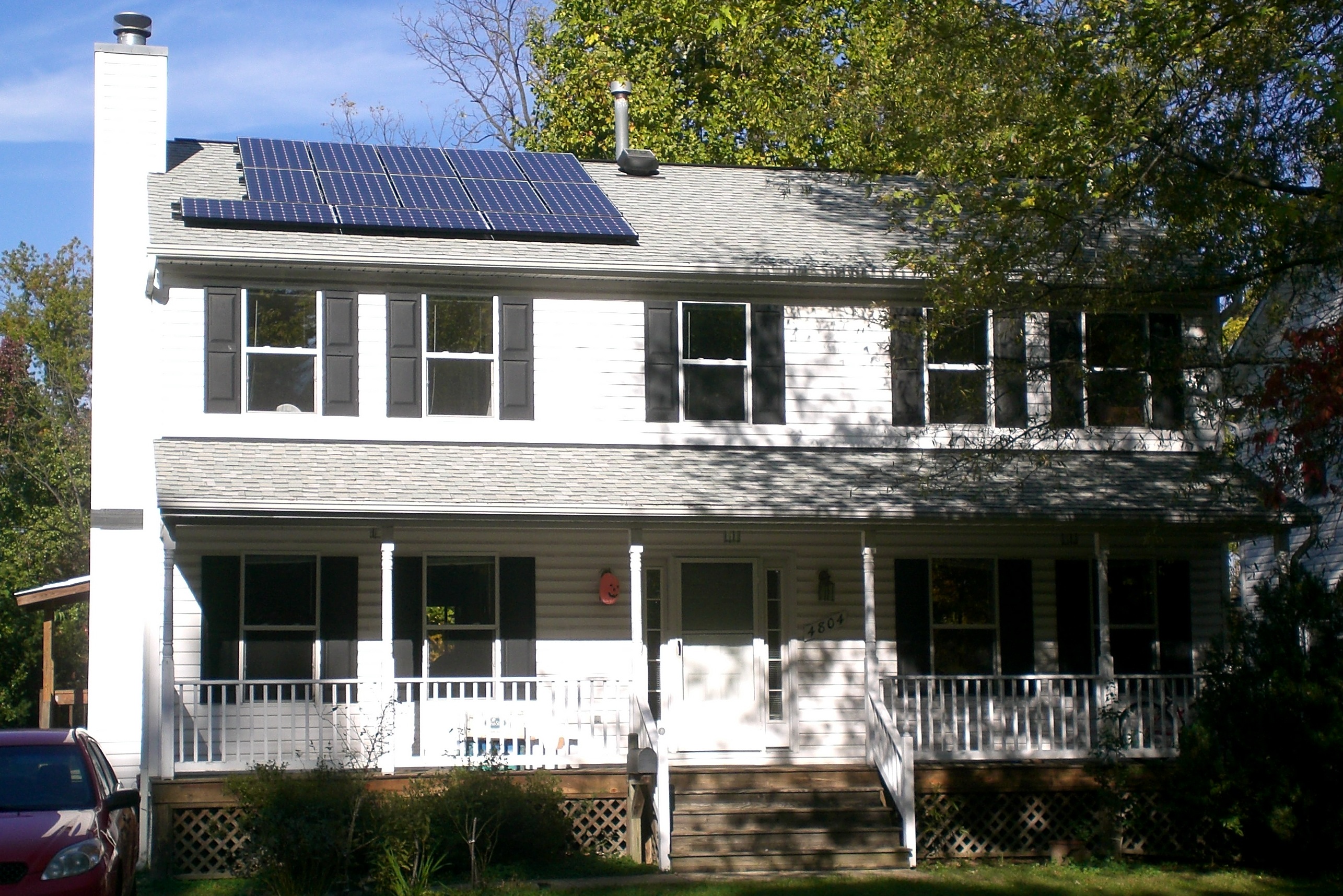Solar-Powered Home of Victor M. Yakovenko
On January 26, 2011, an array of solar photovoltaic (PV) panels was installed on the roof of the home of Victor and Irina Yakovenko in College Park, Maryland. This Web page presents brief information about this PV installation, as well as energy efficiency measures implemented in the house.

Link to real-time data from the PV panels.
Link to a presentation first delivered as a colloquium at the Physics Department of UMD on January 31, 2012 and last updated on November 25, 2016.
Features and description of the house submitted for annual participation (2012, 2013, 2014, 2016) in the Tour of Solar Homes, which is always conducted on the first weekend of October every year:
Features
- PV solar panels with battery backup system
- Elements of passive solar home
- Cool roof
- Superinsulation
- Energy efficient appliances
- High efficiency low-E windows
- High efficiency lighting
- Low water consumption
Description
13 Sanyo HIT Power 215A panels (2.795 kW total) with Enphase microinverters and battery backup system were installed by Standard Solar (now Standard Energy Solutions) in January and October 2011 (10 + 3 panels). Solar cell efficiency is 19.3%, and module efficiency is 17.1%.
The panels generate about 2.8 MWh/year, which is greater than our current electricity consumption of 2.5 MWh/year. By July 2017, the panels have generated 18 MWh, which is equivalent to 11 barrels of oil. The PV system is grid-tied with net metering. Our electric meter reading today is lower than it was 5 years ago, so the house is a net producer of electricity.
The battery backup system enables PV operation during grid outages and supplies electricity to critical loads. It operated during the big, memorable outages in January (huge snow storm) and August (hurricane Irene) of 2011. Hurricane Sandy in October 2012 did not cause significant outage in our area.
By improving energy efficiency, our annual electricity consumption was reduced from 6 MWh in 2010 to 2.5 MWh now.
Closed-cell no-VOC foam insulation was injected into exterior walls by USA insulation on April 12, 2011. The better wall insulation and thermal curtains for windows greatly reduce AC usage for cooling (47 days in 2011, 31 in 2012, 15 in 2013, 6 in 2014, 18 in 2015, but 38 in 2016) and natural gas for heating.
All lights are LEDs. Appliances are selected for high efficiency by DOE ranking at EnergyStar.gov. New kitchen fridge (GE) consumes less than 1 kWh/day instead of 2 kWh/day for the old one.
All electronic devices are on switched power strips to prevent vampire power. Using tablets (iPads) instead of desktop computers and laptops noticeably reduces electricity consumption.
Summer humidity in a large basement is controlled by the super-efficient dehumidifier Santa Fe Impact XT bought in March 2012. Its total electricity consumption was only 260 kWh in 2013, 230 kWh in 2014, 168 kWh in 2015, 212 kWh in 2016.
Concrete walls of basement (top to bottom) are sealed by spray-on foam, insulated by fiberglass bats, and covered by fluted plastic.
Band joists (space between concrete walls of basement and wooden floor of the 1st floor) are sealed with spray-on foam and insulated by Rock Wool.
Roof and attic overheating in summer is reduced by Solaris reflective shingles (reflectance over 40%), reflective foil in the attic, and ridge vent to maintain good air circulation in the attic.
South-facing windows provide passive solar space heating in winter. Using lower thermostat settings in winter results in better humidity. Glass doors and all windows were replaced by more efficient low-E models of Thompson Creek.
Showerheads are low-flow, and Cimarron toilets are highly efficient.
For objective measurements, we use Kill-a-Watt electricity meter; humidity, temperature and CO2 meters; and Black-and-Decker thermal leak detector.
Single-use batteries (AA, AAA, and such) in low-power devices are progressively replaced by rechargeable batteries (Ni-metal hydride or Li) to eliminate battery waste.
Last updated
June 29, 2017
Home
page of Victor Yakovenko

